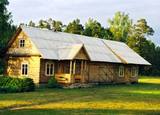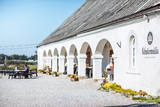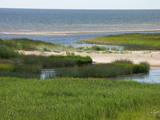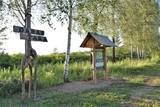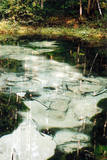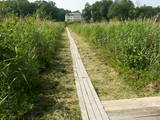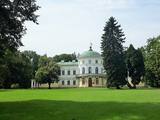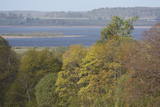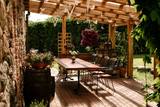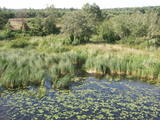| Nr | Nosaukums | Apraksts |
|---|---|---|
|
Lauku sētas atrodas pie upītes, ciema nomalē, kas jau izsenis bijusi mājvieta biškopjiem. Vieta piemērota mierīgai atpūtai. Izglītojošas nodarbības ikvienam, kas ir ieinteresēts Dzūkijas kulinārajā mantojuma, amatniecībā un tradīcijās. Maizes cepšana, pīrāgi ar sēnēm, olu rotāšana ar vasku, pinumi no salmiem. Vakarēšana ar dzuku dziesmām un dejām. Tautastērpu izgatavošana gan bērniem, gan pieaugušajiem. |
||
|
Atrodas Valmieras ziemeļdaļā. Valmiermuižas kungu māju (neobaroka stils) laikā no 1764. – 1771. g. cēla Šlēsvigas – Holšteinas – Zodenburgas – Bekas princis Pēteris Augusts Frīdrihs. Vēlākajos laikos tā pieder vairākiem citiem īpašniekiem. Pēc mūsdienās atrodamām liecībām varam spriest, ka muižas kungu māja 20. gs. sākumā bija vienstāvu ēka ar barokālu tornīti un divstāvu blakuskorpusu. Tā bija piemērota kā vasarnīca un medību izpriecu vieta. 1918. g. ēku nodedzina. Divus gadus vēlāk Valmiermuižā ierīko karagūstekņu nometni. Vēlāk kungu mājas piebūvi atjauno un izmanto kā pamatskolu. 1936. gadā ēkā izveido cietumu, kas 2. pasaules kara laikā kļūst par karagūstekņu ieslodzījuma vietu. Pēcāk ēka nodeg, un drupas tiek nojauktas. Līdz mūsdienām ir saglabājies Valmiermuižas tornis, kura telpu griestu gleznojumi tāpat kā parks ir kultūras piemineklis. Mūsdienās blakus vēsturiskajai vietai izveidota Valmiermuižas alusdarītava, un Valmiermuiža ir atguvusi otro elpu. |
||
|
„Ainaži – Salacgrīva” - nozīmīga teritorija rifu aizsardzībai. Teritorija atrodas iepretim Salacgrīvas novadam, tās platība ir 7239 ha.
|
||
|
Kokneses dabas taka (5,65 km) ved gar Daugavas un Pērses krastiem un savieno Kokneses parku un Likteņdārzu. Pastaigā pa dabas taku var doties no jebkuras sevis izvēlētas vietas, kas vijas cauri Kokneses parkam. Takā izveidotas laipas, tiltiņi, informācijas stendi un norādes. |
||
|
Dzūkijas Nacionālais parks dibināts 1991. gadā. Tā ir lielākā Lietuvas īpaši aizsargājamā dabas teritorija un viens no mežainākajiem valsts apvidiem. Nacionālais parks ir bagāts ar upēm, kuru krastos nereti redzami iespaidīgi nogulumiežu atsegumi, kā arī simtiem avotu un avoksnāju. Starp vērtīgiem biotopiem pieminamas arī pļavas un palieņu pļavas, purvi u.c. mitrāji. Kopumā parkā konstatētas gandrīz 2000 augu sugas un 2108 dzīvnieku sugas, kukaiņus u.c. ieskaitot. Viena no nozīmīgākajām kultūrvēstures vērtībām ir etnogrāfiskie ciemi un saglabātās biškopības, amatniecības, arhitektūras, kulinārās u.c. Cilvēki izsenis dzīvojuši saskaņā ar dabu un izmantojuši tās bagātības – ogas, sēnes, bišu medu, tīro avotu un upju ūdeni un piekopuši dažādu amatu un biškopības tradīcijas. Pazīstama Dzūku tradīcija ir sēņu un ogu vākšana plašajos mežos. Parkā ir izveidoti kājāmgājēju, velotūrisma un ūdenstūrisma maršruti. Apmeklētāju centri atrodas Merķines (Merkinė) pilsētā un Marcinkoņa (Marcinkonys) ciemā. |
||
|
Atrodas Katedrāles ielā 1. Ķemeru vecākā baznīca celta 1893. g. Ziemeļkrievijas koka baznīcu arhitektūras formās (arhitekts V. Lunskis). Pie dievnama apglabāti 1. pasaules karā kritušie 97 krievu karavīri, kuriem 1925. g. atklāts piemineklis - melns marmora krusts. Netālu no baznīcas meklējami 2. pasaules karā kritušo un pēc kara no ievainojumiem mirušo padomju karavīru brāļu kapi un piemineklis. Šī ir senākā Ķemeru baznīca. Pēc nostāstiem tā ir celta bez nevienas naglas. Baznīcā var ieiet dievkalpojumu laikā, taču apmeklētājiem jābūt atbilstoši ģērbtiem! Pārējā laikā ēka apskatāma no ārpuses. |
||
|
Piritas upes kreisajā krastā izveidojušies trīs avotu ezeriņi ar daudzām izverdošām avotu „acīm” – katrs savā krāsā (zilganzaļā, baltā un tumšā), veidojot dažādas krāsu kombinācijas. Nereti saukti par Igaunijas skaistākajiem avotiem. Kopējais no tiem izplūstošā ūdens daudzums ir 20 – 30 l/s. Saglabājušies nostāsti par avotu dziednieciskajām (īpaši – acīm) īpašībām. Apkārtne labiekārtota.
|
||
|
Ap 100 gadus veca priežu audze, ko iesēja pagājušā gadsimta sākumā. Sēklu materiāls bija nācis no kādas Vācijas (Darmštatē) sēklu tirdzniecības firmas. Mūsu klimatiskajos apstākļos priežu stumbri izauga līki un kroplīgi. Savdabīgā audze labi redzama no šosejas malas.
|
||
|
The first stone castle in Alsunga was built in 1372, starting with the central part of the southern wing. The authorised representative of the Livonian Order, who was subject to a higher-ranking official in Kuldīga, lived here. The guard towers and other parts of the castle were gradually added between the 15th and the 18th century. The Baroque castle with its two towers is quite impressive. The castle is unique in and outside of Latvia in that it is one of the rare Medieval castles to have survived to the present day in part, but in its original historical appearance. The castle offers an exhibition about its history. Visitors can look at a Suiti kitchen, write a letter with a fountain pen in Barbara’s boudoir, or celebrate a special event in the romantic venue of the castle’s round tower. Renovation of the castle began in 2018, and it is closed to visitors. Still, you can look at its exterior and tour its garden. |
||
|
Maršruts "Murjāņi - Līgatne" ved caur Gaujas senieleju ar devona smilšakmens atsegumiem, raksturīgo augu valsti un dzīvniekiem. Krastos sastopami Latvijā lielākie nogāžu un gravu meži ar liepām, ozoliem, gobām un ošiem. Upes līkumos palienē aug baltalkšņu un vīksnu audzes. Uz koku stumbriem atrodams plaušķērpis. Senieleja bagāta ar sausokņiem un kritalām, tāpēc Gaujas krastu mežos dzīvo visu Latvijā sastopamo dzeņu dzimtas sugu putni. Smilšainajās Gaujmalas pļavās un Gaujas vecupēs ir bagātīga bezmugurkaulnieku fauna. Upes krastos ir smilšakmens klintis ar čurkstu alām un zivju dzenīša ligzdām. Klinšu pakājē iztek avoti, kas uztur mikroklimatu ielejā. Gauja ir nozīmīga arī kā Latvijas lielākā lašupe. Maršruts ir daļēji marķēts un papildināts ar norādēm un informācijas stendiem. |
||
|
The best place to look at the restricted area of the Vīķi swamp and the Lielauce lake which is in the middle of that swamp is the Lielauce castle, where a wooden pathway stars. The pathway will lead visitors across the swampy shores of Lake Lielauce and deliver them at a boating area on the open part of the lake. The swamp itself is to the South-east of the lake. The restricted area is there to protect biotopes and species in the area. |
||
|
The blacksmith is eager to show his work and various techniques and tools. He can also show how to make charcoal, and talks about the dwelling house which includes a threshing barn with a huge kiln, and explains how grain was dried, threshed and winnowed in the past. |
||
|
The Baisogalo Estate is one of the oldest ones in Lithuania and is known as a royal castle because it once belonged to the local lord. The ornate late-Classicism buildings were built in the mid-19th century and have survived. The 12 ha landscape park dates back to the early part of the 19th century, with an alley of chestnut trees leading to the estate from the local village. The central alley that starts at the gate weaves through two curvy bodies of water with a bridge and statues of lions. Various trees behind the estate are alongside curvy and narrow pathways. On both sides of the alleys are bodies of water, and deep in the park is a pond with an island. |
||
|
In terms of shape, this is one of the most diverse areas of uncovered sandstone in Latvia. Found on the right bank of the Gauja river, the Sietiņiezis is up to 15m high. Small holes that can be seen in the cliff face are created by single and protected insects, which carve tiny caves in the cliff for their caterpillars. A circular and well appointed trail, with stairs, has been installed. It is 1.5 km in length and will take an hour or so to traverse. Objects are in the Gauja National Park.
|
||
|
This is an institution that offers leisure activities for people of all ages. Creative workshops and various lectures are focused on families to facilitate creativity. There are kites that allow children to release their dreams into the sky. |
||
|
Nature restricted area includes eastern side of the lake with Lanupe River and North-east and South-east coastal areas. Restricted area has been established for protection of birds and floodplain meadows of the lake. To see the nature restricted area visitors do not have to enter it. There are great view points with wind generators of Grobina on the background from the road Vecpils – Rava – Aistere. Coastal areas which are not included in the restricted area are perfectly suitable for bird watching. There is located the smallest city by its population in Latvia to the South from the lake.
|
||
|
The most fascinating part of the Park is its underground museum. Guided underground tours take visitors to where miners used to work and rest and stored their explosives, and include a real train ride and learning about various pieces of equipment and technology. A delicious miner’s lunch can be booked in advance and enjoyed in a genuine miners´ underground canteen. |
||
|
This itinerary allows you to enjoy the Latvian winter at its best. It starts in the bustling capital of Riga with its Christmas market, decorations, shopping facilities, many cultural events and museums as well as a charming Old Town. |
||
|
Here you can tour a local brewery, ride bikes, enjoy water sports, go fishing in the local river, and taste foods with hops. The guesthouse offers tastings of herbal teas and beer. Learn all about traditions in brewing beer. |
||
|
This is a territory which regularly floods when the Lielupe River crosses its banks. These are flood-land meadows of importance to birds. The area can be surveyed from the Rīga-Liepāja highway and the Kalnciems road which runs along it. |
||
